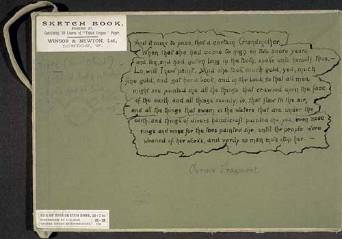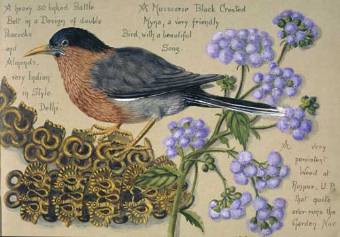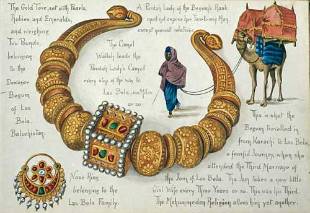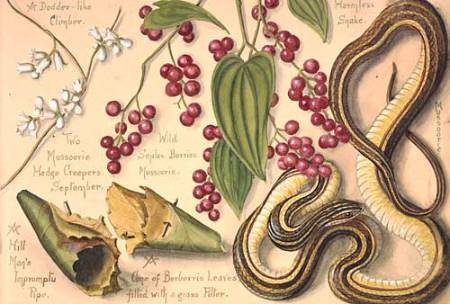Drawings collection of Olivia Frances Tonge (1858-1949)
by Lisa Atalla, Information Assistant
Olivia Fanny Tonge (nee Fitzmaurice) was born in Glamorganshire in 1858. Her Father, Lewis Roper Fitzmaurice (b.1816, London), a mate and assistant surveyor on the H.M.S Beagle under John Lort Stokes was a keen naturalist and painter who specialised in watercolour landscapes. Many of his watercolours were used to illustrate Captain Lort Stokes’ book ‘Discovery in Australia… Voyage of H.M.S Beagle 1837-43’ (London, 1846).
It was from her father that Olivia’s interest in travel and love of nature probably stemmed- although, it has been said he did not have much confidence in her as a painter, being unaware that her inability to draw landscapes was due to being short sighted rather than lack of talent. As a consequence, Olivia’s watercolours were small scale, focussing on flowers, bird and reptiles- things that she could see in detail close up.
At the age of 19, Olivia married Dinely Fowler Tonge, with whom she had two daughters- Blanche and Ermin. At this point she gave up painting, spending time on other creative pursuits. This included writing articles for her friend the Reverend J. G. Wood’s publication ‘The Animal World’ and books such as ‘Petland Revisited’ as well as woodcarving, metalwork, singing, dress design and embroidery.
After her husband died, Olivia had to earn money to support her daughters, and became the needle work editor of ‘Hearth and Home’ for many years. She didn't begin painting again until her eldest daughter began to paint landscapes and portraits.
In 1908, at the age of 50, Olivia embarked on the first of her two trips to India alone. In the preface to her sketchbooks a passage entitled ’Curious Fragment’ shows the determination and independence this would have required .
“And it came to pass that a certain Grandmother, when that she had come to nigh on two score years and ten; and had gotten long in the tooth, spake to herself thus.- Lo, will I now paint… and verily no man mote stop her”
The 16 sketch books, donated to the Natural History Museum Library in 1952 each contain around 30 pages of annotated watercolours made in Sindh, Calcutta, Darjeeling, Mussoorie, Luknow, Karsiyang, Karachi and various other places across India and Pakistan- spanning both of Olivia’s trips in 1908-1910 and 1912-1913.
Unusually, Olivia included cultural elements to her drawings, including people, local jewellery, toys, methods of transport (including working animals) and even local sweets.
The pages were crowded with annotations and intertwining paintings of differing subjects. She depicted local people alongside the local flora and fauna, perhaps showing how the culture of the area is influenced by the natural world around them - and certainly making nature and science more accessible to the non-scientific community at home, who had an interest in the exotic.
Olivia’s annotations were charming and personal- not at all scientific, such as- “ A Mussoorie Black Crested Myna, a very friendly bird with a beautiful song”. The colours she used reflected the vibrancy and richness of the country she travelled in and the experience she was documenting.
In 1913, on her return from India, Olivia again stopped painting- instead, taking up gardening. She died in Lincoln at the age of 90.






